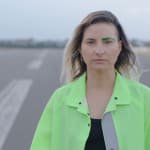Open a larger version of the following image in a popup:
 Pauline Boudry / Renate Lorenz, The Right to Have Rights, 2019
Pauline Boudry / Renate Lorenz, The Right to Have Rights, 2019
 Pauline Boudry / Renate Lorenz, The Right to Have Rights, 2019
Pauline Boudry / Renate Lorenz, The Right to Have Rights, 2019
Open a larger version of the following image in a popup:
 Pauline Boudry / Renate Lorenz, The Right to Have Rights, 2019
Pauline Boudry / Renate Lorenz, The Right to Have Rights, 2019
 Pauline Boudry / Renate Lorenz, The Right to Have Rights, 2019
Pauline Boudry / Renate Lorenz, The Right to Have Rights, 2019
Pauline Boudry / Renate Lorenz
The Right to Have Rights, 2019
Installation with HD video
8 minutes
Edition 3/5 + 2 AP
Copyright The Artist
The Right to Have Rights shows a performer (MPA) who speaks the text of the so-called 1951 Geneva Convention (Convention Relating to the Status of Refugees), a protocol by which...
The Right to Have Rights shows a performer (MPA) who speaks the text of the so-called 1951 Geneva Convention (Convention Relating to the Status of Refugees), a protocol by which 145 states guaranteed wide-ranging rights to people on refuge and which in theory is still valid at present. Instead of delivering this statement in a lecture hall and addressing an audience, it is here re-located to an empty runway at the former Tempelhof Airport in Berlin. The performer's speech has been partially altered through digital processing and turned into a piece of electronic music or into a song, even though this song is by someone human but not quite. Who is seen as "human" and who can access rights?


